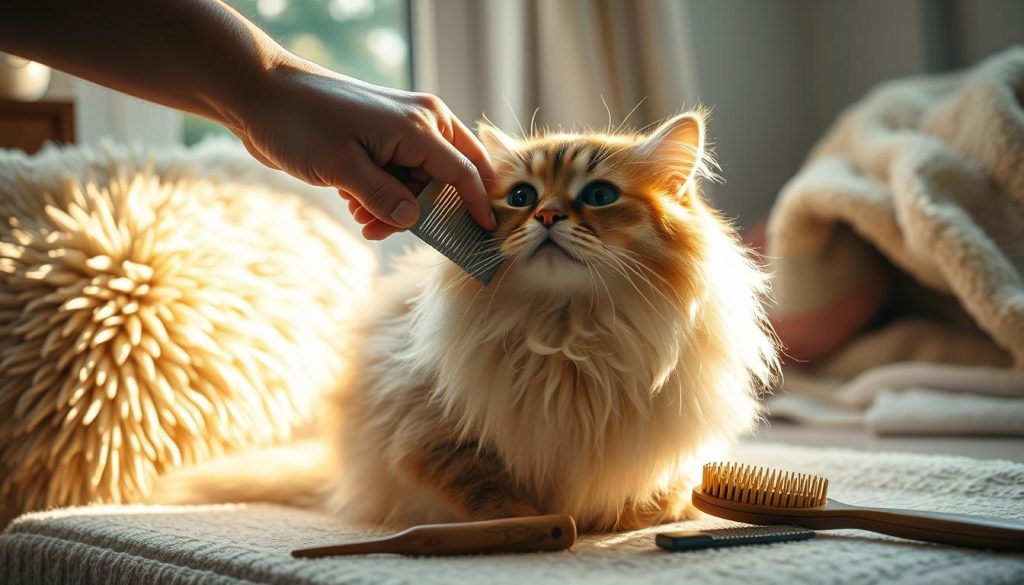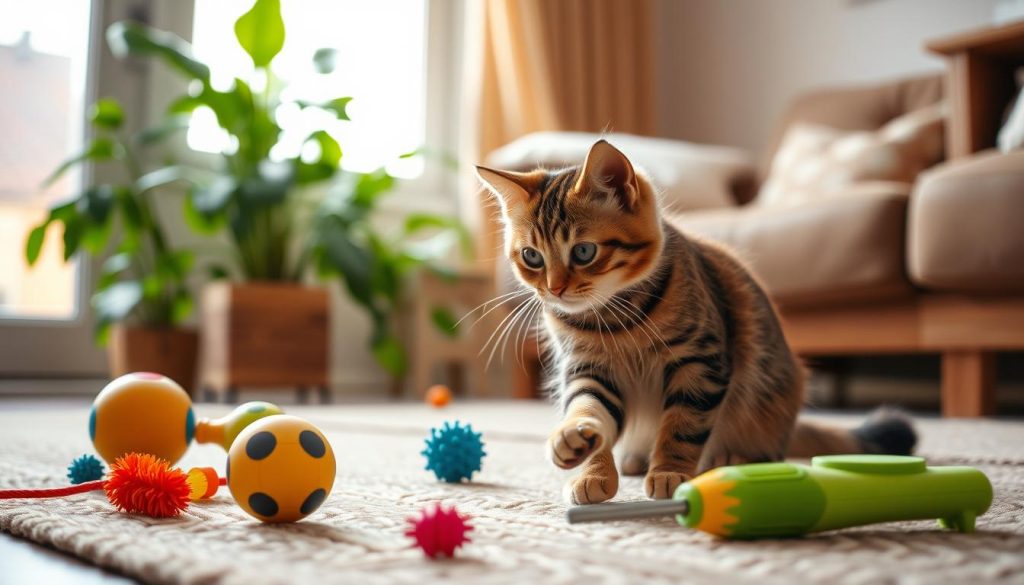As a proud cat parent, I’ve learned that providing exceptional care for our feline friends is crucial for their overall health and happiness. In this comprehensive guide, I’ll share essential cat care tips that every loving pet owner should know. From understanding your cat’s needs to mastering grooming routines, we’ll cover the key aspects of caring for your beloved companion. Whether you’re a new cat owner or a seasoned pro, this article will equip you with the knowledge and insights to ensure your cat thrives.
Understanding Your Cat’s Needs
As cat owners, it’s key to know what our feline friends need. By reading their body language and making their environment fun, we help them thrive. This way, they feel happy and content in our care.
Decoding Feline Body Language
Cats talk to us in many ways, and learning these cues is important. A cat that blinks slowly is usually happy. But, if their tail twitches or ears fold back, they might need some space or feel uncomfortable. Watching how they stand, what their face looks like, and how they sound helps us meet their needs better.
Providing a Stimulating Environment
- Give them different toys and scratching posts to play and scratch.
- Make sure they have places to climb and see from up high, like cat trees or window perches.
- Add new things to their space, like cardboard boxes or paper bags, to keep them curious.
- Play with them using wand toys or lasers to keep their minds and bodies active.
| Cat Enrichment Needs | Examples |
|---|---|
| Physical Enrichment | Scratching posts, cat trees, interactive toys |
| Mental Enrichment | Puzzle feeders, treat-dispensing toys, cardboard boxes |
| Social Enrichment | Play time with owners, cat-friendly companion pets |
By understanding our cats’ needs and making their environment fun, we build a strong bond. This ensures they live happy, healthy lives.
Nutritional Essentials for a Healthy Cat
Proper cat nutrition is key to your cat’s health and long life. As a pet owner, knowing what your cat needs is important. We’ll look at the right mix of proteins, fats, and carbohydrates for cats. Plus, we’ll talk about choosing good cat food, the right amount to feed, and when to feed.
Cats need animal-based proteins because they are obligate carnivores. These macronutrients are the base of a cat’s diet. They give cats the amino acids, vitamins, and minerals they need to grow and stay healthy. Cats also need fats for energy, a shiny coat, and overall health.
When feeding your cat, it’s important to control portions. Cats have different caloric intake needs based on their age, activity level, and health. By knowing your cat’s needs and feeding the right amount of healthy cat food, you help them stay at a healthy weight and avoid nutritional problems.
| Nutrient | Optimal Percentage |
|---|---|
| Protein | 35-45% |
| Fat | 20-30% |
| Carbohydrates | 10-20% |
By understanding and meeting your cat’s dietary needs, you can help them live a long, healthy, and happy life.
Grooming and Hygiene Routines

Keeping your cat’s cat grooming and cat hygiene in check is key for their comfort and health. Proper cat bathing and cat brushing help keep their coat healthy. This also prevents skin irritations.
Brushing and Bathing Your Feline Friend
Regular cat brushing is vital for your cat’s grooming. Brush your cat’s cat coat care a few times a week. This removes loose hair, spreads skin oils, and lowers hairball risks.
Start brushing slowly and use treats to make it fun. This helps your cat enjoy the process.
Cat bathing is not always a hit with cats, but it’s needed. Bathe your cat every few months with a gentle, cat-safe shampoo. Make sure the water is just right, and be patient and gentle. Give your cat treats and praise after to make them happy.
Don’t forget about cat nail trimming. It keeps their nails from getting too long and causing harm. Ask your vet or a groomer for tips on how and when to trim.
| Grooming Task | Frequency | Benefits |
|---|---|---|
| Brushing | 2-3 times per week | Reduces shedding, prevents hairballs, and distributes skin oils |
| Bathing | Every 2-3 months | Removes dirt, oils, and odors, and maintains skin and coat health |
| Nail Trimming | Every 4-6 weeks | Prevents overgrowth, scratching, and potential injury |
Cat care: Creating a Safe Haven

Making your home safe and comfy for your cat is key. As a cat owner, you must protect your space from dangers. This way, your cat stays safe and happy. Let’s look at how to make a cat-friendly home that meets your pet’s needs.
Start by finding and fixing any risky spots in your home. Block off dangerous areas like balconies and windows. Also, keep your cat away from electrical cords and sharp things. Make sure to remove any plants that are bad for cats so they can play without worry.
It’s also vital to give your cat a fun and safe place to play. Get furniture that won’t get scratched up and put toys and climbing spots around. This keeps your cat busy and happy, preventing bad behavior.
- Secure access to dangerous areas like balconies, stairways, and windows
- Protect your cat from electrical cords, sharp edges, and small objects
- Remove any plants that are toxic to cats
- Provide scratch-resistant furniture and surfaces
- Incorporate interactive toys, cat trees, and perches for enrichment
By cat-proofing your home and making it fun, your cat will have a great life. A few easy steps can make your home safe and fun for your cat.
Training Your Cat: A Positive Approach

Many of us think cat training is hard or not worth it. But, cats can learn just like dogs. Using positive methods, we can build a strong bond and teach them good habits.
Litter Box Training Made Easy
Teaching your cat to use the litter box is key. It keeps your home clean and stops bad habits. Knowing what your cat likes is the first step.
- Put litter boxes in quiet spots around the house.
- Choose a litter your cat likes, like fine-grained and unscented.
- Clean the litter boxes often to keep them fresh.
- Give treats or praise when your cat uses the box right.
- Stay patient and keep training up, as cats learn slowly.
By following these tips, you can help your cat use the litter box well. This makes your home a happier place.
| Positive Reinforcement Training Techniques | Benefits |
|---|---|
| Clicker Training | Helps cats learn new behaviors quickly and effectively |
| Reward-Based Training | Strengthens the bond between you and your cat |
| Targeting | Teaches cats to focus and respond to cues |
Success in cat training comes from being patient, consistent, and positive. Using these methods, you’ll not only solve behavior problems but also grow closer to your cat.
Veterinary Care: Keeping Your Cat Healthy
As a devoted cat owner, I know how crucial it is to give my feline friend top-notch veterinary care. Regular check-ups and preventive steps are key to keeping my cat healthy. I work closely with my vet to ensure my cat gets the care they need.
Routine wellness exams help my vet spot health issues early. They can do screenings, suggest vaccinations, and offer advice on diet and grooming. This way, I know my cat is getting the best care to stay healthy.
I also keep a close eye on my cat’s behavior and health. If I notice any changes, like a different appetite or lethargy, I quickly call my vet. This helps prevent small problems from becoming big ones.

